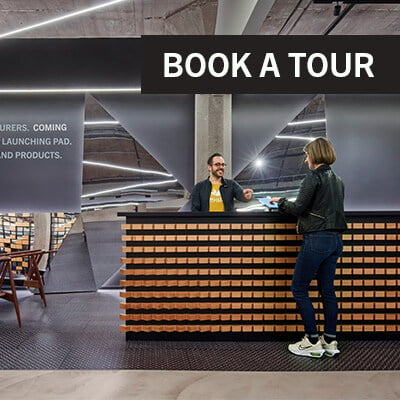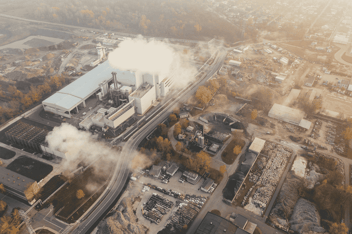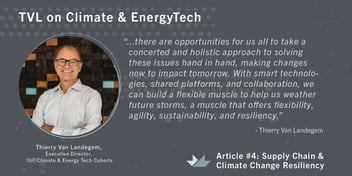When it comes to climate tech, lately, I am thinking a lot about dreamcatchers – or in Ojibwe: asabikeshiinh. These handmade willow hoops on which a web is woven and hung above a cradle or bed as protection. We might need a huge one above planet earth catching all the carbon because reading about climate change and carbon emissions are despairing at times.
In its recent report Impacts, Adaptation, and Vulnerability, the Intergovernmental Panel on Climate Change (IPCC) details the manifold impacts of current and future emissions. “The cumulative scientific evidence is unequivocal: Climate change is a threat to human well-being and planetary health. Any further delay in concerted anticipatory global action on adaptation and mitigation will miss a brief and rapidly closing window of opportunity to secure a livable and sustainable future for all.”
Even this year’s Super Bowl showed the most climate-related ads ever. And John Kerry, the US Special Presidential Envoy for Climate, was clear on the need for action in a COP26 session on accelerating and scaling climate innovation in Glasgow: “Nobody is moving fast enough”.
There is a silver lining to this. I see stakeholders such as investors, corporations, employees, entrepreneurs, and consumers working on solutions for climate change that will impact tomorrow. I see this, especially from my role at mHUB, the nation’s leading hardtech innovation center. In my conversations with startups, I see their work accelerating change overall and pushing forward the climate agenda at major corporations.
That also became very clear during the recent GreenBiz 2022 conference. Investors are no longer happy with corporations’ vague climate goals, they want to see a specific plan that shows action. Net-positive should be the new focus to ensure a sustainable future, according to Pol Polman, former CEO of Unilever and climate evangelist. Net-positive is where the positive impact of businesses on the environment is higher than the negative impact such as emitted greenhouse gases.
Sustainability continues to remain a hot topic in the workplace. In Deloitte’s 2021 millennial and Gen Z survey, 49% of respondents between age 18 – 25 and 44% of respondents between ages 26 – 38 said they’d picked their work and employers based on their personal ethics – climate change being a top concern. Employees will put more pressure on their company leaders to create more environmentally conscious culture.

What commitments and actions are companies taking? Several have made big announcements setting net-zero carbon emissions, driven by consumer demand and country regulations. However, actions have been far from adequate. A recent report on climate transition disclosure by nonprofit group CDP showed that only a third of the more than 13,000 surveyed companies have credible emission reduction targets, and fewer than 10% have independently validated science-based targets.
We see signs that we are past the time of ‘green washing’ by businesses and their CEOs. In a survey of U.S. CEOs conducted by EY, 25% are pursuing M&A activities this year for strengthening their ESG (Environmental, Social and Governance) performance or improving their sustainability footprint, outranking acquisition focused on increasing operational capabilities, of technology, talent, new production capabilities or innovative startups. CEOs have adopted ESG for strategic reasons such as competitive advantage or lower cost of capital, and not pressure from regulators.
One can only manage what one measures, though – that will be an important lever on the net-zero journey. Measuring the carbon footprint of a product is a challenge as one needs to break down the full journey of that product to its smallest components and its operation of it. When it comes to sustainability there is no lack of rankings and ratings – Dow Jones Sustainability Indices, the CDP A-list, the Corporate Knights’ Global 100, the Just 100 to name a few.
Ratings and rankings need to focus on a few important dimensions:
- Does the company understand the impact of its full value chain, from sourcing materials for components, to producing its products, to the operation of its products up to the end of life and recyclability?
- Does the company have a plan to reduce or even eliminate that impact? How ambitious is such plan?
- Does that plan come with a clear timetable and milestones? How trustworthy are the numbers it gets from supply chain partners?
- How does the company disclose its progress towards its goal? Does it communicate that progress to all its stakeholders, and is it transparent and engaging towards the broader community and society?
Once known, both organizations and consumers can make informed buying decisions.
Even if these ratings and rankings are mostly used by the world’s top 100 companies today, it includes their full value chain. This means that it is triggering an enormous changeover in the middle-market-sized companies that make the blunt of the value chain.
To put climate change and the impact of climate change in perspective, Breakthrough Energy notes that every year the world adds 51B tons of greenhouse gases. The major sources of these emissions are 31% from manufacturing, electricity generation contributes 27%, agriculture counts for 19%, transportation contributes 16%, and emissions in the building sector accounted for 7%. What lots of people tend to forget is that in today’s world a big portion of carbon emission is the result of transporting energy resources like fossil fuels. A fully electrified world will be much more local than today’s global energy system; according to the IEA, global energy trade will be one-third of what it is today.

In its reporting, McKinsey argues that each of these systems will need to undergo a transformation if the net-zero goal is to be achieved. For companies, this is not just about introducing one technology, it is a strategic transformation of the whole company, impacting the whole ecosystem as all systems are highly interdependent. For example, electric vehicles lead to overall emissions reductions only to the extent that low-emissions electricity production has been achieved. In all, their analysis suggests that the net-zero 2050 scenario would require physical assets spending of about $275 trillion between 2021 and 2050 (about 7.5 percent of GDP over the period). Moving from 80% of energy coming from fossil fuels to net-zero by 2050 would take a ‘Herculean effort’ according to the IEA. This spending will be front-loaded in said period and uneven across those sectors.
BCG shows there is a huge opportunity at the supply chain level too. For companies, especially those in consumer-facing sectors, end-to-end supply chain emissions (in base materials, agriculture, and shipping) are much higher than the direct emissions produced during final manufacturing. Implementing net-zero supply chains can amplify their climate impact, enable emission reductions in hard-to-abate sectors, and accelerate climate action in countries where it would otherwise not be high on the agenda. In most supply chains, the costs of getting to net-zero are surprisingly low. Even full decarbonization would result in end-consumer price increases of only 1% to 4% in the medium term—less than $1 on a $40 pair of jeans, according to BCG.
Although we see huge progress in renewable energy, the road to full carbonization will be a long one. The good thing is that in the last COP26 meeting in Glasgow there was a much broader uptake in the business community when it comes to climate change. However, the gap between what we are doing and what needs to be done is getting bigger. Organizations such as mHUB can help accelerate startups by offering hardtech services in prototyping new products, funding in this capital-intensive field, and collaboration with corporations to spur pilots of new products and services.
The path to a net-zero future is one focusing on zero-carbon and low-carbon emitting technologies. Renewable energy and greater energy efficiency are the obvious enablers for the decarbonization efforts of manufacturing and heavy industries. In both areas, a tremendous amount of innovation still needs to happen. We also need the heavy industry emitters to be compensated for by carbon capture, utilization, and storage (CCUS) technologies that remove carbon from the atmosphere. According to IEA, there is unprecedented momentum for CCUS, with plans for more than 100 new facilities announced in 2021. However, not only is the capacity far from enough, the economics behind it are challenging, and the question is what to do with that captured carbon.
In summary, there are plenty of opportunities for entrepreneurs and innovators in the broader climate and energy space. My optimism is founded exactly on my belief in innovation and entrepreneurship. Two essential traits are the essence and foundation of who mHUB is. With our upcoming cohort focused on Climate & Energy Tech we will be making a difference as we are bringing together these early-stage startups with the necessary hardtech services experience, the funding of such capital-intensive opportunities, and the collaboration with leading corporations in the field. Applications to our cohort remain open till March 28, 2022. If you miss this deadline and would like to express interest in an upcoming accelerator cohort, please complete the form below.
About the Author: Thierry Van Landegem leads the Climate & Energy Tech as well as the Smart Manufacturing & Industrial IoT cohort of the mHUB Accelerator, a program that fast-tracks hardtech startups on their journey to becoming scalable, profitable, and sustainable businesses. He is responsible for startup sourcing and evaluation, as well as program development and execution. Thierry brings over 25 years of innovation leadership with a focus on creating sustainable business impact. He has extensive venture building and startup incubation experience in the telecom, internet, automotive, energy and manufacturing industries launching new corporate product lines, incubations, ventures and startups.






